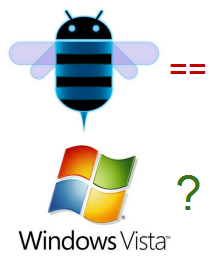Is Honeycomb Android's Vista?


By many measures Vista was a vast improvement over its predecessor. 5 years in the making, it introduced the visually stunning Aero interface, integrated search, better security, ReadyBoost, SuperFetch, IPv6, Direct3D 10, and more. By mid-2008, over 180 million copies had been sold.
This pales in comparison to Windows XP, however. The industry breathed a sigh of relief when Vista was replaced in 2009 with Windows 7. By early 2011, Win7 sales passed 300 million. Many enterprise customers skipped Vista altogether and went from XP to Win7.
What was wrong with Vista (and Honeycomb)?
So what was wrong with Vista? There were a number of individual problems such as incompatibility with older devices, and a penchant for asking for security permission on many common operations. But I think the biggest one was perception.
Consider that in its first year of availability, PC World named it as the biggest tech disappointment of 2007, and InfoWorld rated it #2 on a list of Tech's all-time flops. Just the mention of the name "Vista" was enough to scare off potential users. In one marketing campaign users rated Vista 4.4 out of 10 but gave a new operating system named "Mojave" 8.5 out of 10. Mojave was just Vista with a different name.
Now compare that with how Windows 7 was received. PC World named it one of the best products of 2009. CNET described Win7 as "what Vista should have been", giving it 4.5 out of 5 stars. Techradar called it "the best Windows OS ever".
Win7 must have been a major rewrite of Vista for this kind of turnaround, right? Nope. Windows 7 is basically Vista with a few focused, incremental enhancements such as a new Taskbar, transparent window borders, and some performance tweaks. The system requirements are the same as Vista, and the drivers are the same.
If some hardware didn't work with Vista it wouldn't work with Win7 either. But everybody loved it. Vista had a bad reputation, but Windows 7 got a good reputation.
Lately, I see Honeycomb being maligned in the press. Jason Perlow called it "half-baked" and "a piece of junk". John Paczkowki says the Motorola Xoom (the first tablet to run Honeycomb) is "at best a dud, at worst a bomb". Is that perception or reality?
Continue reading: Perception vs. reality >
I use Honeycomb on the Xoom every day. In my opinion, Honeycomb is great, but the Xoom not so much. The Xoom is too heavy, too expensive, and too unfinished. When people ask me what to buy I tell them to check out the alternatives from others like Acer, Asus, LG, Samsung, and Sony. Unfortunately the taint of problems with the first Honeycomb tablet have rubbed off on the operating system itself.
Honeycomb has a few rough edges but it also has a lot to love. Stacked widgets let you flip through documents and movies like a Rolodex. Action bars make commands that were previously hidden deep in the menus visible for instant selection. Fragments let developers create reusable components that can be laid out differently in landscape and portrait modes. Notifications are bigger and richer than ever. The mail and calendar clients are just as good or better than anything you'll find on the iPad. And the browser is excellent, with multiple tabs and very fast rendering without the checkboard fill-in pattern you see on other devices.
Compatibility with older applications is a work in progress. Unfortunately in Google's Market application there's no way to filter out apps that have and haven't been tested on the extra large screen. I have managed to lock up my Xoom three or four times, requiring me to hold the power and volume buttons to reboot it, probably due to device driver bugs. And while this won't affect regular users, the emulator used by developers is dog slow because of all the 3d graphics needed by the Honeycomb UI.
The way forward for Google and Android is clear. Don't bother defending Honeycomb - just get the next version ("IceCream") out the door.
IceCream to the rescue
What Windows 7 did for Vista, IceCream will do for Honeycomb. IceCream will basically be Honeycomb with a few focused, incremental enhancements. It will run on the same hardware as Honeycomb, plus it will be portable to phones. It will feel more polished because, well, more time was spent polishing it.
Google withheld the source code to Honeycomb because it wasn't ready for prime time. IceCream will be open. That means more ports, more custom ROMS, and better bug reports, bug fixes, and other contributions.
I predict that reviewers that panned Honeycomb will love IceCream. Eventually the memory of Honeycomb, like Vista, will fade into history.